Last Updated on October 18, 2023
Grow Asian pear trees in your garden for a beautiful early spring bloom and an exotic, mouthwatering, prolific and long lasting fruit.
Have you seen Asian pears in your neighboring supermarket this fall and winter?
Unfortunately, these tasty, crunchy apple-shaped, sweet pear-flavored fruits are not readily available in all grocery stores and if you happen to find them, they are so ridiculously expensive!
But if you live in USDA zones 5-9, you are in luck, because you can grow Asian pear trees in your garden or backyard and harvest a bunch of luscious fruit each midsummer – late autumn. And the good news – Asian pears are quite pest resistant, easy to grow and care for, and will store exceptionally well in your fridge.
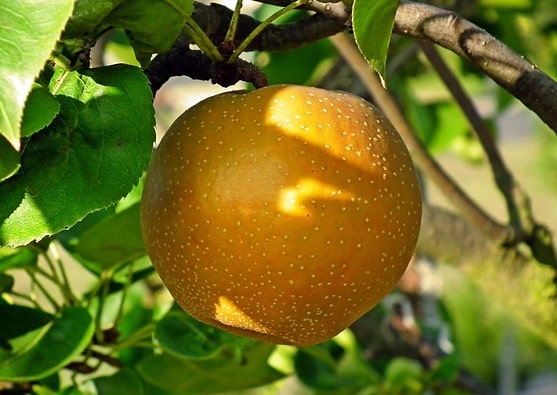
✅ You can get a super hardy Olympic Asian pear tree delivered to your door from Amazon. It bears extra-large, sweet, juicy fruit that holds its flavor for up to 6 month in storage.
*This post contains affiliate links. If you choose to purchase any of the products I have recommended, I may receive a commission at no cost to you.
Asian pear tree at glance
- Asian pear tree (Pyrus pyrifolia)
- Also known as Chinese pear, Japanese pear, Oriental pear, Nashi pear, Sand pear or Apple pear
- Origin: native to China, Korea and Japan
- Asian pear tree zones: 5-9 in the U.S.
- Hardiness: up to – 10 Fahrenheit
- Asian pear tree height: most grafted trees that you get from the nursery will grow 15-20 feet tall, dwarf cultivars will grow 8-15 feet tall
- Plant spacing: 20 – 50 feet
- Time to maturity: 2 – 5 years
Asian pear types
Asian pear trees produce fruits of two types:
1. Smooth skinned with sweet mild flavor.
2. Brown colored skin (Bosc pear color like) with intense pear flavor.
Asian pear tree varieties (by ripening time)
There are a few ways to group Asian pear tree varieties. The most common one and useful for home gardeners will be dividing Asian pear cultivars into 3 groups depending on their fruit ripening time.
Asian pears ripen in different times starting from mid summer till late autumn.
Early ripening Asian pear tree varieties (July-August): Kosui, Shinseiki, Chojuro, Ichiban, Hamese.
Mid season ripening (late summer-beginning of fall): Shinko, Hosui, Yoinashi, 20th Century (Nijisseiki) Asian Pear tree.
Late season (ripens in October-November) – Korean Giant (Olympian), Tsu Li, Sauri.
Do you need two Asian pear trees for pollination?
There are some Asian pear tree varieties that are self pollinating – Nijisseiki (also known as ’20th Century’) and Shinseiki (also known as ‘New Century’).
But even with the self fertile varieties, adding an additional Asian pear tree will significantly increase the size of your crop.
The majority of Asian pear trees are not self-pollinating, and you will need to plant another pear tree nearby (which can be Asian or European pear tree varieties that bloom at the same time as your Asian pear tree) for cross pollination.
So be sure before buying your Asian pear tree to check if a pollinator is needed and which variety of pear tree should be used as a pollinator. Luckily, each online nursery store provides this information.
How long does it take for Asian pear tree to bear fruit
It takes anywhere from 1 to 4 years for the Asian pear tree to bear fruit depending on the variety and the age of the tree you’ve got.
5 best Asian pear tree varieties for home growers
1. Shinseiki Asian Pear Tree
(also known as ‘New Century’)
produces well even in warm southern climates (requires less than 300 chill hours)
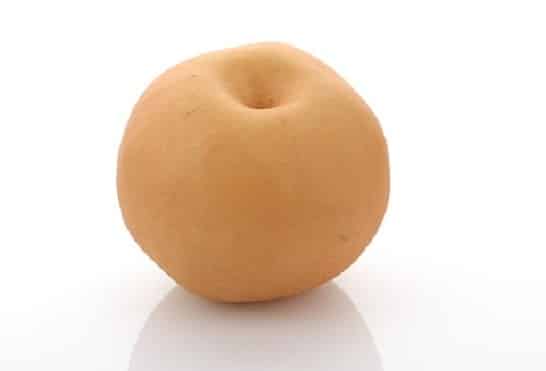
Shinseiki Asian pear offered by Amazon.
- self fertile
- produces firm lemon yellow round fruit that has long shelf life
- resembles Granny Smith apples in flavor and texture
- resist pests and diseases
- heavy producer
- ripens in August
- bears fruit on the second or third year
Watch a YouTube video by EyeOnAiman about growing the Sninseiki Asain pear tree.
2. Chojuro Asian Pear Tree
most widely sold in supermarkets
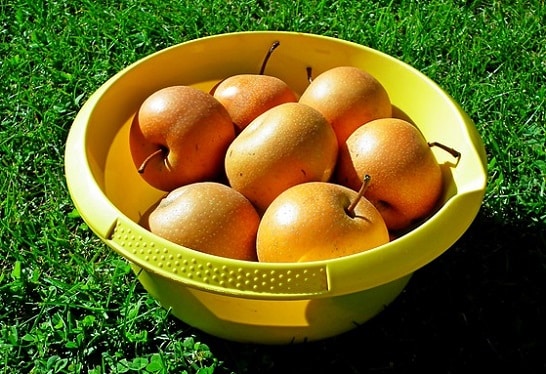
Chojuro pear tree is offered by Home Depot online at a very attractive price.
- butterscotch flavor
- large fruit
- shelf life up to 5 months
- heavy producer
- bears fruit first season
- ripens early to mid-August
3. Hosui Asian Pear Tree
the winner of many taste surveys
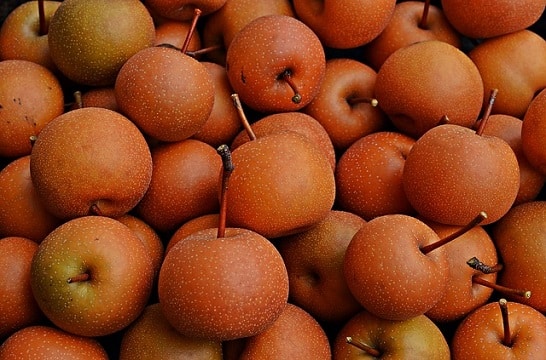
Hosui Asian Pear – ships from Home Depot orStark Bro’s
- brandy aroma and rich flavor
- very juicy fruit medium size fruit
- shelf life – 2 months
- ripens early to mid-September
- susceptible to fire blight
4. Olympic Giant Asian Pear
(also sold as ‘Korean Giant’, ‘Olympic’, ‘Dan Beh’)
bears extra large fruit, disease resistant

Korean Giant Asian Pear – offered by Amazon.
- super juicy with earthy flavor
- extra large size fruit
- fruit holds its flavor for up to six months in storage
- ripens late in October
- no spray required – resists pests and diseases
- trees begin to bear fruit in their third year
- needs a pollinator, like Bartlett or Bradford pear
5. Nijisseiki Asian Pear Tree
(also known as ‘20th Century’)
most adaptive, grows well in any climate
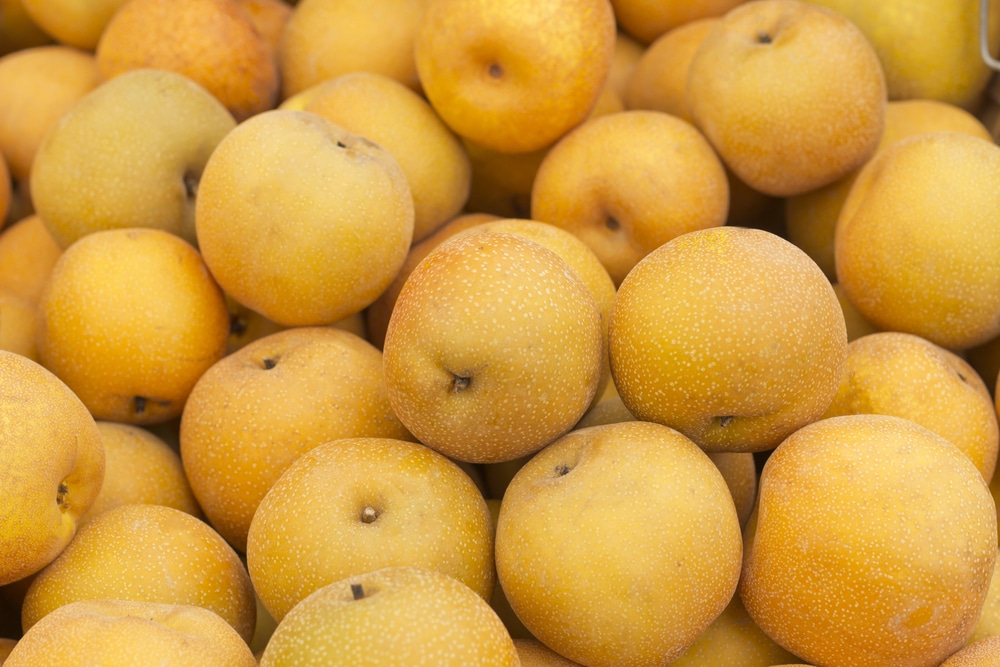
Nijisseiki – the sweetest and juiciest Asian Pear. Available on Amazon.
- cold hardy down to -20°F, yet grows comfortably in warm southern states
- very sweet, has flavor and texture that resembles a watermelon
- bear fruit in 1 year
- self fertile
- harvest in August-October.
Where can you buy an Asian pear tree?
You can get Asian pear trees at your local nursery, garden center, or online.
If you choose an online option for convenience, then check out:
How much does an Asian pear tree cost?
The prices for Asian pear trees vary widely .
You can expect to pay anywhere between $30-$120 for an Asian pear tree with the average price being around $60 – but it will depend greatly on where you buy them, as well as what size they are.
You’ll pay less at Amazon, Lowes or Home Depot than you would to at an online nursery that specializes in fruiting plants.
Where is the best place to plant an Asian pear tree?
Asian pear trees should be planted in a well drained location that gets at least 8 hours of sunlight per day, southern exposure is preferable.
Be sure to plant it in a sheltered location away from high winds or at least stake your tree.
When and how to plant Asian pear
An Asian pear prefers 6.3 -6.8 soil pH, so you can mix some peat with the soil when preparing a planting hole.
You can fertilize a newly planted tree with a pound of 10-10-10 fertilizer in early April, just be sure to keep fertilizer 15 inches away from the trunk. Fertilizing is optional though.
After planting a tree, water it and put a layer of mulch (2”-4” deep) around the trunk, just don’t let the mulch touch the trunk.
You can plant Asian pear trees in the spring or fall.
Read more about planting fruit trees in fall.
How do you care for an Asian pear tree?
Your Asian pear tree will require watering, mulching, pruning and fruit thinning to bear abundant fruit for you.
1. Watering
First year after planting, water your Asian pear tree weekly when there is no heavy rain in forecast and the top 1-2 inches of soil around the tree base is dry.
An established tree can be watered not as frequently – give your Asian pear a thorough soaking when the soil is dry 2-3 inches down. Remember. a regular water supply prevents fruit from cracking.
2. Mulching
Place 2-4 inches of mulch around tree to keep roots cool during summer and warm during winter.
3. Pruning
When planting an Asian pear tree, it should be cut back to one main branch 2-3 feet from the ground.
After one season of Asian pear tree growth during the winter dormant period, remove any limbs that are growing lower than 18 inches from the ground. Choose four to six of the best branches above that point to keep, and remove the rest.
Watch how Asian pear tree pruning is done in this YouTube video:
4. Blossom and fruit thinning
Asian pear trees will often develop more fruit than the branches can physically support, so thinning is important to keep breakage in check.
In the spring, when the tree is in bloom, simply remove about half of the flowers in each cluster.
To encourage larger fruit to form, thin again by using pruners 1 month after blossom drop leaving just one largest fruit in the cluster.
Harvesting and storing Asian pears
When should you harvest Asian pears? And how to tell if an Asian pear is ripe?
Let your Asian pears ripen on the tree.
If they’re ready, you’ll be able to pick them just by lifting a bit from the branch – they should separate easily.
The other way to determine ripeness is by taste, smell, and appearance. Asian pears smell and taste sweet when they are ripe! The skin color of ripe Asian pears should be yellow or deep brown, but not green.
How to store Asian pears
Asian pears need to be refrigerated.
Alternatively, after harvesting your late ripening Asian pear varieties – wrap them in paper towels and store them in a bin in a cool attic – you can get a sweet treat at Christmas time!
How long does Asian pear last?
Asian pears are well known for their excellent shelf life.
Asian pears can last 2-5 months in the refrigerator depending on the variety. Korean Giant Asian pear can hold well up to 6 months in storage.
Related reading:
Final thoughts on growing Asian pear trees
Asian pear trees are a great addition to your home orchard. You will love how they look year-round, and the fruit is very sweet and mouthwatering!
Plant one (or two for pollination :)) today for an easy way to get more delicious fruit on your table in years to come.
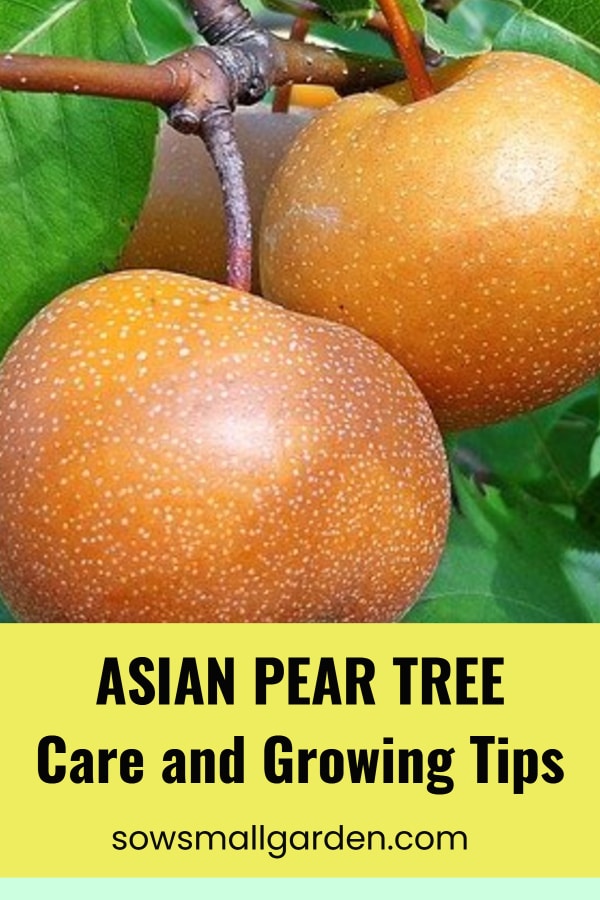
Pin for later reference!
Image sources: Deposit Photo; also images by cndretail, MrGajowy3 , Krzysztof Jaracz from Pixabay under Creative Commons Zero (CC0) license
You have read:


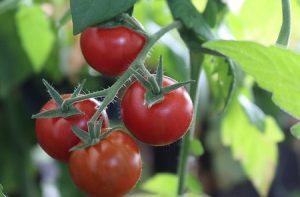
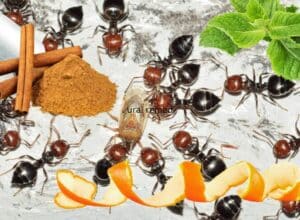

hi,
my area has fire blight, and I want to get Asian pear trees that are resistant to fire blight.
Do you have a list of Asian Pears that are resistant to fire blight?
Randy
thanks
Hi, Randy
Thank you for your question.
Unfortunately, no Asian pear varieties are truly resistant to fire blight.
I tried to search the subject and found just one article claiming that according to https://extension.psu.edu/apple-and-pear-disease-fire-blight Chojuro, Kikusui, Kosui, Seuri, Shinko, Shinsui, Singo, Tsu Li, and Ya Li show some degree of resistance to fire blight, but when I actually read this article, I didn’t find this information. They just say that resistant (European) pear varieties include Magness and Moonglow.
From my own experience (zone 7): I had Asian pears (Chojuro and Olympic Giant) and European pears (Bosh and Barlett) growing in my backyard, and while European pears got fire blight, the Asian pear trees didn’t get it.
Hi,
Great article .
Which one of them is the smallest ? I want to grow one in a Avery tight space like 5×5’
Thanks
Sunny
Hi, Sunny!
Thanks for asking.
You can choose Shinseiki Asian Pear. First of all, Shinseiki Asian Pears are self-fertile, so you will get fruit with only one plant. Also, Shinseiki Asian pear has a strong central leader and tends to grow into a vertical oval if you prune it. If not pruned, it will grow tall limbs vertically to form a circular evergreen shape.
Happy gardening!